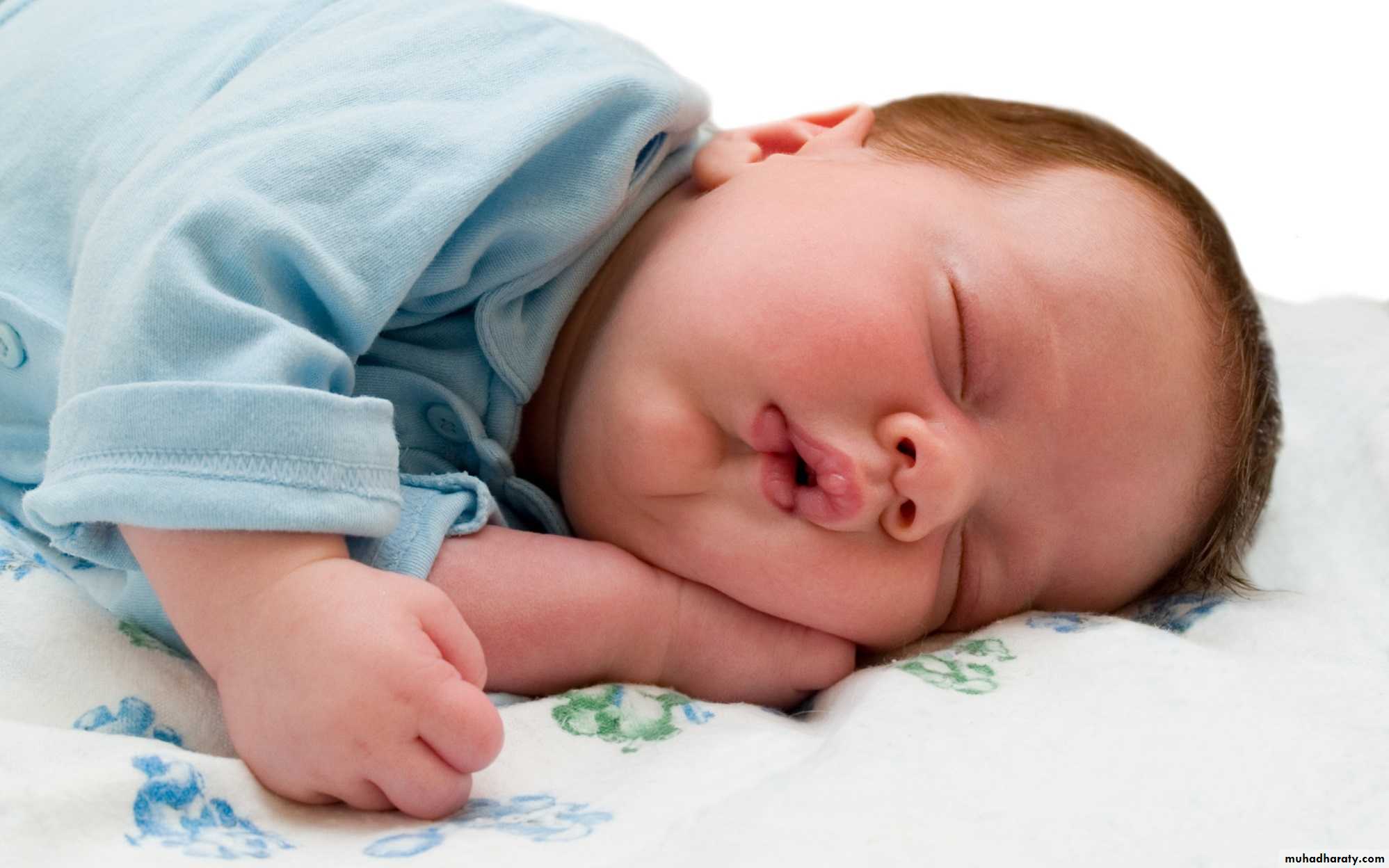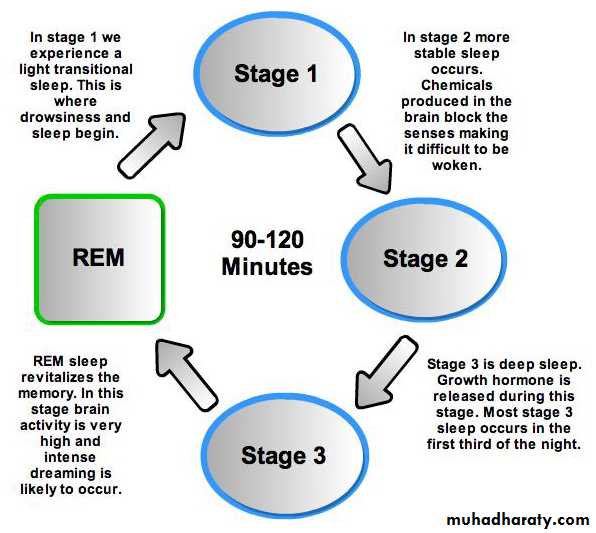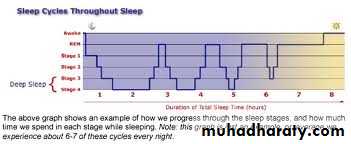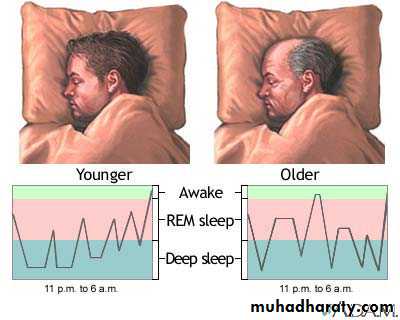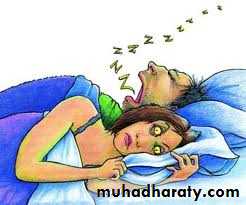Prof. Dr. Elham Aljammas
10\ Dec. \ 2013Is a natural recurrent state of disturbed consciousness(completely or partially lost)in which there is rest of the mind &body.
sleep
non-rapid eye movement (NREM or non-REM)sleep
rapid eye movement (REM)sleepSleep stages
Sleep proceeds in cycles of REM and NREM, the order normally being N1 → N2 → N3 → N2 → REM. There is a greater amount of deep sleep (stage N3) earlier in the sleep cycle, while the proportion of REM sleep increases later in the sleep cycle and just before natural awakening.
sleep
Stage N1 refers to the transition of the brain from alpha waves having a frequency of 8–13 Hz (common in the awake state) to theta waves having a frequency of 4–7 Hz. This stage is sometimes referred to as somnolence or drowsy sleep. Sudden twitches and hypnic jerks, also known as positive myoclonus, may be associated with the onset of sleep during N1. During N1, the subject loses some muscle tone and most conscious awareness of the external environment.
(NREM or non-REM)sleep
Stage N2 is characterized by sleep spindles ranging from 11 to 16 Hz (most commonly 12–14 Hz) and K-complexes. During this stage, muscular activity as measured by EMG decreases, and conscious awareness of the external environment disappears. This stage occupies 45–55% of total sleep in adults.(NREM or non-REM)sleep
Stage N3 (deep or slow-wave sleep) is characterized by the presence of a minimum of 20% delta waves ranging from 0.5–2 Hz. This is the stage in which parasomnias such as night terrors, nocturnal enuresis, sleepwalking, and somniloquy occur.Many illustrations and descriptions still show a stage N3 with 20–50% delta waves and a stage N4 with greater than 50% delta waves; these have been combined as stage N3.
(NREM or non-REM)sleep
The criteria for REM sleep include rapid eye movements as well as a rapid low-voltage EEG. Most memorable dreaming occurs in this stage. At least in mammals, a descending muscular atonia is seen. Such paralysis may be necessary to protect organisms from self-damage through physically acting out scenes from the often-vivid dreams that occur during this stage. It start 90 min after sleep also called paradoxical sleep
(REM)sleep
Infant spend half their sleep in rem
20-25% by age of five
18% in adult
Elderly 3-4%
(REM)sleep
Most researchers think that sleep is regulated by small numbers of interconnecting systems or center that locate chiefly in the brain stem and that mutually activate and inhibit one another
Many studies support the role of serotonin in sleep regulation, lack of serotonin found to reduce sleep for considerable time
also Adenosine which is created over the course of the day, high levels of adenosine lead to sleepiness
Sleep regulation
Restoration of homeostatic function
Appear to be crucial for normal thermal regulation and energy conservationRem stage may associated with satisfying metabolic needs
Function of sleep
Prolong period of sleep deprivation lead to ego disorganization
Rem deprivation lead to irritability and lethargySleep debt is the effect of not getting enough rest and sleep; a large debt causes mental, emotional and physical fatigue.
Sleep debt results in diminished abilities to perform high-level cognitive functions.
Sleep deprivation & sleep debt
Some persons normally sleep fewer than 6 hours to function adequately called short sleeper
Those who sleep more than9 hours each night called long sleeperLong sleeper have more rem sleep
Sleep need increased with physical work, exercise, illness, pregnancy, general mental stress and increased mental activity
Sleep requirement
Dreams
State of consciousness in which remembered image and fantasies which are temporarily confused with external reality
Dreaming is the perceived experience of sensory images and sounds during sleep, in a sequence which the dreamer usually perceives more as an apparent participant than as an observer
dreams
Freud’s theory : His psycholytic theory states that dreams are unconscious wish fulfillment of need unmet during waking states . He believe that dreams often involve combination of early childhood experience and daily residueTheories
Cognitive theory : proposes that dreaming can best be understood by relying on the same cognitive concept that are used in studying the waking mind , it mean that dreams involve in processing information, memorization and possibly problem solving .
Theories
Activation-synthesis theory : this theory state that dreams are powered by spontaneous firing of neurons,
dreams reflect the brains effort to make sense out or find meaning in the neuronal activity take place during sleep
Theories
Do you know when you are dreaming ?
Yes some times during occasional awakingCan people control the content of their dreams?
Yes by pre dream suggestion post hypnotic suggestiondreaming
Do males and females dream about different things?
Males dreams have more content about males , aggression , gross anatomy , sexuality and dreamer involve successFemales dreams are more likely to be about females, friends and victimization
dreaming
Why cant we remember all of our dreams ?We cant because dreaming occur at such a low level of consciousness , we remember it best we awake while dreaming or just after

